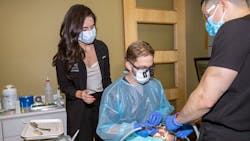RCC Spotlight: Stephanie Botts, PosturePros
She has been a practicing clinical hygienist for 13 years. Over time, Stephanie noticed increasing pain due to the repetitive motions in a static position that the practice of dental hygiene requires. She began to ask herself, “What will my body feel like 10 years from now, or in 20? Will I be able to enjoy my retirement or will I be in chronic pain due to my career?”
Dentistry has some of the highest pain and disability rates of any profession. The prevalence of musculoskeletal pain and musculoskeletal disorders (MSDs) in dental hygienists is well documented, ranging from 64% to 96%.1-3
Stephanie knew that she needed to do things differently if she wanted to continue in her career. She began making some ergonomic changes and immediately noticed that she had less pain and fatigue, was more productive, and had energy at the end of the day and on weekends to do the things she enjoyed. Improving ergonomics in the operatory was working, and Stephanie decided to learn more, so she took an online course to become a certified ergonomics assessment specialist.
RCC Spotlight
Hygienists for Humanity
Mr. RDH
In April 2021, Stephanie created PosturePros, which offers customized ergonomics assessment and coaching to all members of the dental team. She also presents continuing education courses on ergonomics in dentistry, an area of insufficient training for many hygienists. She says, “I get so inspired when I’m working with practitioners. We in dentistry are so caring and empathetic to our patients. We take such good care of them. But we need to take that caring attitude and refocus it on ourselves. If we aren’t caring for ourselves, we cannot provide excellent care to our patients, not to mention our loved ones outside of work. I am big on quality of life, and incorporating ergonomics into practice will help us be happier and healthier to do the things we enjoy. We cannot be fully engaged with our loved ones if we are exhausted or in pain.
“My favorite part of coaching is when I offer a suggestion and immediately see the practitioner’s body relax when they try it. Oftentimes, ergonomics is about making minor changes to the way we practice, but it makes all the difference.”
Through her dual roles as dental hygiene practitioner and ergonomics specialist, Stephanie has improved the quality of life for her patients and her fellow hygienists. Of her hygiene career, Stephanie says, “Dental hygiene is a fascinating and rewarding career. I love the preventive nature of our work, and the impact we can have on our patients’ lives.”
Contact Stephanie at [email protected]. You can also connect on Facebook (stephanie.botts.rdh) and Instagram (@steph.posturepros).
Congratulations, Stephanie Botts, and welcome to the RDH Community Connections (RCC) dental hygiene influencer program!
Editor's note: This article appeared in the February 2022 print edition of RDH magazine.
References
- Hayes M, Cockrell D, Smith DR. A systematic review of musculoskeletal disorders among dental professionals. Int J Dent Hyg. 2009;7(3):159-165. doi:10.1111/j.1601-5037.2009.00395.x
- Hayes MJ, Smith DR, Cockrell D. Prevalence and correlates of musculoskeletal disorders among Australian dental hygiene students. Int J Dent Hyg. 2009;7(3):176-181. doi:10.1111/j.1601-5037.2009.00370.x
- Yochim AS. Musculoskeletal disorder prevention in dental hygiene. J Calif Dent Hyg Assoc. 2018;36(2):19-23.
About the Author
Kirsten Brancheau, BA, RDH
Kirsten Brancheau, BA, RDH, practiced clinical dental hygiene from 1978 until her retirement in 2025. She continues to work occasionally as a temp. Kirsten earned an associate’s degree in applied science in dental hygiene from Union County College and a bachelor of arts degree in English literature from Montclair State University. She is a member of the American Dental Hygienists’ Association. Kirsten is also a freelance proofreader, editor, and writer. She can be reached at [email protected].


